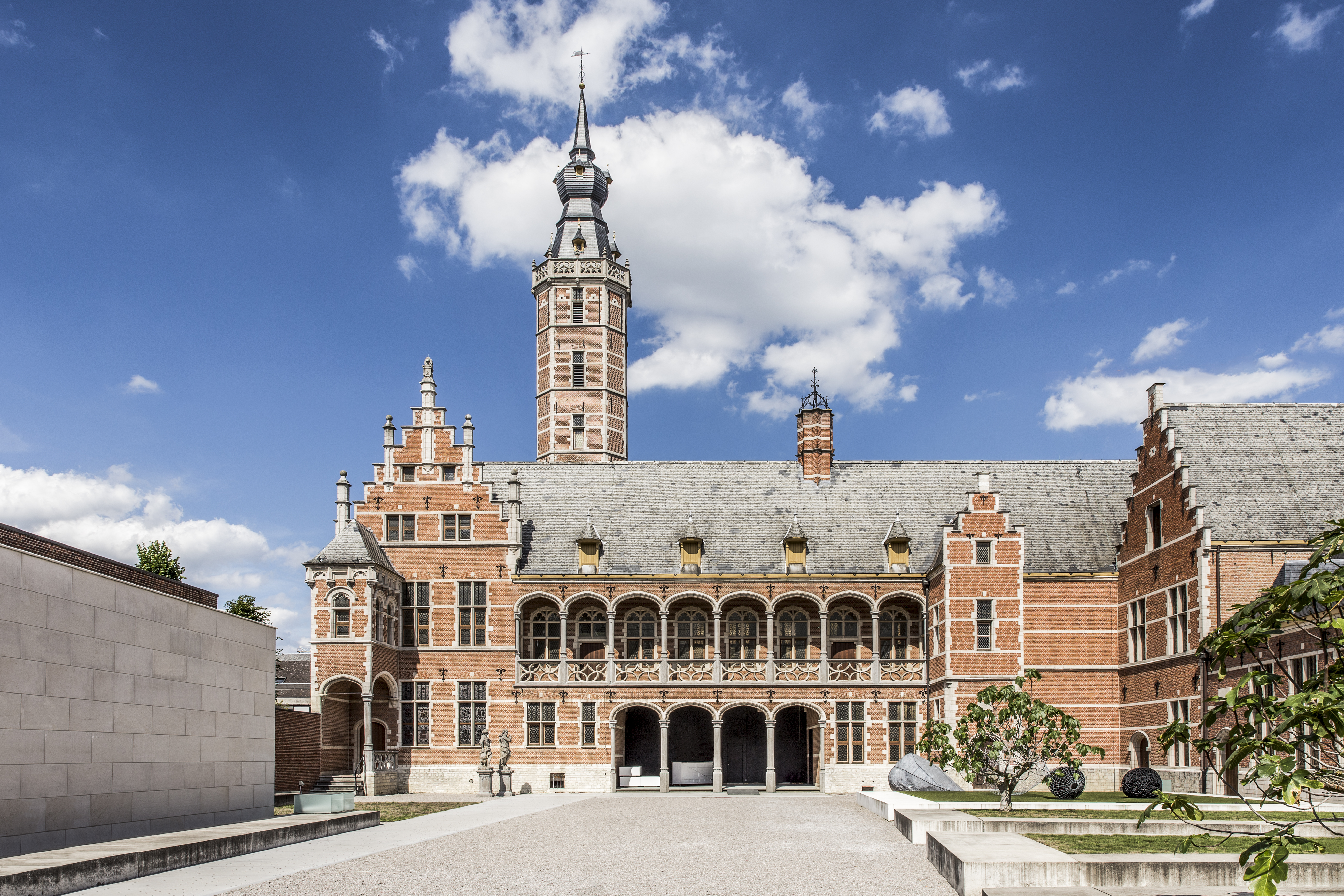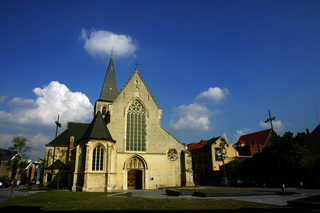concert venues
St. Rumbold's Cathedral - Mechelen Cultural Centre - St. Peter & Paul Church - Church of Our Lady-across-the-Dyle - Hof van Busleyden - Kunstencentrum nona - City Theatre Mechelen - Diocesan Pastoral Centre - Elisabeth Hotel - Church of St Catherine - Scheppers Institute Hall - Manufactuur De Wit
ST. RUMBOLD'S CATHEDRAL

St. Rumbold's Cathedral was built in the 13th century and is the main church of the Mechelen-Brussels archdiocese. It is considerably larger and more imposing than all the other parish churches. The church has become one of the city of Mechelen’s most eye-catching buildings. The interior is breathtaking. You can admire the painting of ‘Christ on the Cross’ by Anthony van Dyck, as well as works by artists including Michel Coxcie, Gaspard de Crayer and Abraham Janssens. The showpiece of the church is Lucas Faydherbe’s high altar, dating from 1665.
MECHELEN CULTURAL
CENTRE

Mechelen Cultural Centre saw the light of day in 1958, as Antoon Spinoy Cultural Centre, long before ‘cultural centres’ were a familiar concept. The restoration of the Old Friars Minor Church marked its official relaunch. The reopening of the city theatre in 2000 brought new opportunities for the performing arts, and De Garage, which also opened in 2000, provided space for contemporary visual arts. Since 2001, the cultural centre has been among the most important in Flanders, organising around 150 of its own activities and hosting another 180 each year. The centre is constantly on the move, for example with the creation of an artistic workplace for young people, H30.
ST. PETER & PAUL CHURCH

This beautiful, harmonious Baroque church was originally dedicated by the Jesuits to Saint Ignatius and Saint Francis Xavier. After the abolition of the Jesuit order, the parish of Saint Peter and Paul asks if she can make it its parish church, because its own church is very dilapidated. The handover takes place and officially the name of the church has since been "Saints Peter and Saint Paul on a visitation to Saints Saints Ignatius and Saint Francis Xavier". In short, you speak of Sint-Petrus-en-Pauluskerk or - in Dutch - Sint-Pieter-en-Paulkerk. The interior is richly decorated. The pulpit symbolizes the missionary work of Saint Francis Xavier in the four continents. At that time (late sixteenth century) Oceania was not yet named the fifth continent. Look at how Europe is depicted, with the cornucopia and the wisdom in the book. The fourteen built-in confessionals are a fine example of Mechelen woodcarving. Legend has it that the church had so many confessional tables, because it was close to the Veemarkt and there was plenty of lying and cheating when selling cattle. The real reason? The Saint Peter and Paul Church was originally a pilgrimage church and there were many relics to be found. If you wanted to touch it, you had to be free from sin. Hence the large number of confessionals.
CHURCH OF OUR LADY-ACROSS-THE-DYLE

This church is built on the left bank of the Dyle on the site where the first parish church of Mechelen is believed to have stood. The imposing church was built in Brabantine Gothic style during the 14th, 15th and 16th centuries. A three-aisled nave of seven bays connects to the five-sided choir closure, ambulatory and trans chapels. After the heavy damage of the Second World War, the current lantern spire was added and the church got the beautiful new stained glass windows, both designed by Jan Lauwers. The church houses "The Miraculous Catch of Fish" (1618-1619) by Pieter Paul Rubens.
HOF VAN BUSLEYDEN

Step inside the Hof van Busleyden and re-experience the Burgundian Netherlands. This Renaissance city palace was the home of Hieronymus van Busleyden, who received guests including Thomas More and Erasmus. Humanists through and through, they exchanged thoughts and discussed philosophy, studying exotic objects from distant lands and other collections of art objects. Today the city palace is once again a place for encounters and conversations, ideas and discoveries, life in the city, art gems, beauty and mastery. It fosters meetings, interactions and involvement with society, driven by the arts, culture and the imagination.
KUNSTENCENTRUM NONA

Kunstencentrum nona is an arts centre that focuses on all kinds of encounters and confrontations between visitors and artists, local and international events, art and education. Nona works to develop, produce and present theatre and music theatre, dance, performance, jazz and the visual arts. It does so during the regular cultural season as well as at a festival (the annual Brand! jazz festival) and a biennale at exciting locations in Mechelen (Contour Moving Image Biennale).
CITY THEATRE MECHELEN

The City Theatre of Mechelen dates from 1480. Originally, the building was the reception area of Margaret of York's palace. At the beginning of the seventeenth century it became a theater. The city theater is a modern theater with comfortable artist's lounges and an atmospheric foyer with murals by students of Gustave van de Woestyne.
DIOCESAN PASTORAL CENTRE

The current complex of the former Archdiocesan Major Seminary of Mechelen was commissioned by Cardinal d’Alsace and mainly built in the period between 1746 and 1761. Completed in 1786 under Joseph II and sold under French rule, the building was returned to the archdiocese. It was extended in 1887 to its current size. The complex is now used as a diocesan pastoral centre. The rooms have been converted into offices for meetings and seminars.
ELISABETH HOTEL

Elisabeth Hotel is a former hospital dating from the interwar period, which has been transformed into a cosy, modern four-star hotel with respect for the original architecture. In consideration of the building’s history, the hotel’s motto is ‘good taste, health and service with that extra touch’. The result is a stylish setting that radiates peace and serenity.
CHURCH OF ST. CATHERINE

The Gothic Church of St Catherine was built in the fourteenth century. Since September 2018, the restoration works of the interior have been completed and the building is fully accessible again. The church is full of references to Catherine, a mythical figure from the Roman period. Legend has it that she refused to renounce her Christian faith and the Roman emperor sentenced her to death on the wheel. Other references to Catherine include twelve rose windows in the nave recalling Catherine's instrument of torture, the wheel, and a beautiful rose window in the façade.
SCHEPPERS INSTITUTE HALL

The Scheppers Institute in the heart of Mechelen hides a beautiful banquet hall from 1902. This hundred-year-old banquet hall with stucco ceilings and cast iron balustrades is a pearl for the eye. During school days, the hall is used as a refectory and room for expression, etc. At other times the hall is used for performances and school parties.
MANUFACTUUR DE WIT

The Royal Manufacturers De Wit, located in the Refuge of the Abbey of Tongerlo, has focused on tapestries since 1889. Today this family business restores antique collection pieces from world museums such as the Louvre, the St. John Co-cathedral Malta, the National Museum Stockholm,... The combination of sophisticated technologies and a talented team makes the Manufactuur a highly appreciated brand in the world. of conservation. De Wit is also active in the trade of antique and modern pieces. Curious? Welcome for a guided visit: see www.dewit.be.







